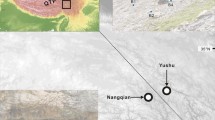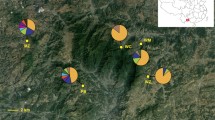Abstract
We examined the origins of cultivated stocks of the endangered species Primula sieboldii at the individual plant level by using an assignment test based on eight microsatellite loci and regional features of chloroplast DNA (cpDNA) variation of wild populations. To confirm that we had sufficient information for estimating the origins of the stocks, we performed an assignment test with 920 genets that we collected from 32 wild populations with known origins. The test assigned 99.6% of the genets to the population from which they had been sampled, confirming the suitability of the method. We then performed the assignment test with 29 cultivated stocks. The alleged origins of 19 were confirmed by microsatellite and cpDNA variations. In contrast, the alleged origins of five were rejected by both markers. Five stocks, which do not have a reference population located within 30 km of their reputed origin, were not assigned to any population. Stocks whose alleged origins were rejected are inappropriate as restoration materials, because their introduction might disturb local gene pools. Six stock haplotypes could not be detected in wild populations. This may suggest the loss of genetic diversity in the wild and the value of stocks as a gene bank. The genetic method used in this study will also be helpful to detect cryptic invasion by nonendemic genotypes or to trace the origins of plants collected for commercial purposes, a threat to many endangered species.


Similar content being viewed by others
References
Congiu L, Dupanloup I, Patarnello T, Fontana F, Rossi R, Arlati G, Zane L (2001) Identification of interspecific hybrids by amplified fragment length polymorphism: the case of sturgeon. Mol Ecol 10:2355–2359
Deguilloux MF, Pemonge MH, Bertel L, Kremer A, Petit J (2003) Checking the geographical origin of oak wood: molecular and statistical tools. Mol Ecol 12:1629–1636
Demauro MM (1993) Relationship of breeding system to rarity in the lakeside daisy (Hymenoxys acaulis var. glabra). Conserv Biol 7:542–550
Environment Agency of Japan (2000) Threatened wildlife of Japan, red data book, vascular plants. Environment Agency of Japan, Tokyo (in Japanese)
Frantz AC, Pourtois T, Heuertz M, Schley L, Flamand MC, Krier A, Bertouille S, Chaumont F, Burke T (2006) Genetic structure and assignment tests demonstrate illegal translocation of red deer (Cervus elaphus) into a continuous population. Mol Ecol 15:3191–3203
Friesen N, Pollner S, Bachmann K, Blattner FR (1999) RAPDs and noncoding chloroplast DNA reveal a single origin of the cultivated Allium fistulosum from A. altaicum (Alliaceae). Am J Bot 86:554–562
Hare MP, Allen SK Jr, Bloomer P, Camara MD, Carnegie RB, Murfree J, Luckenbach M, Meritt D, Morrison C, Paynter K, Reece KS, Rose CG (2006) A genetic test for recruitment enhancement in Chesapeake Bay oysters, Crassostrea virginica, after population supplementation with a disease tolerant strain. Conserv Genet 7:717–734
Hogbin PM, Peakall R (1999) Evaluation of the contribution of genetic research to the management of the endangered plant Zieria prostrata. Conserv Biol 13:514–522
Honjo M (2005) Molecular ecological genetics for the conservation of genetic diversity in Primula sieboldii. Doctoral dissertation, University of Tsukuba (in Japanese)
Honjo M, Kitamoto N, Ueno S, Tsumura Y, Washitani I, Ohsawa R (in press) Managing units of the endangered herb Primula sieboldii based on microsatellite variation among and within populations throughout Japan. Conserv Genet doi:10.1007/s10592-007-9292-4
Honjo M, Ueno S, Tsumura Y, Washitani I, Ohsawa R (2004) Phylogeographic study based on intraspecific sequence variation of chloroplast DNA for the conservation of genetic diversity in the Japanese endangered species Primula sieboldii. Biol Conserv 120:215–224
Hufford KM, Mazer SJ (2003) Plant ecotypes: genetic differentiation in the age of ecological restoration. Trends Ecol Evol 18:147–155
Ibanez O, Calero C, Mayol M, Rossello JA (1999) Isozyme uniformity in a wild extinct insular plant, Lysimachia minoricensis J.J. Rodr. (Primulaceae). Mol Ecol 8:813–817
Isagi Y, Honjo M, Washitani I (2001) Development of microsatellite markers for Primula sieboldii using degenerate oligonucleotide-primed PCR-amplified DNA. Mol Ecol Notes 1:22–24
Kitamoto N, Honjo M, Ueno S, Takenaka A, Tsumura Y, Washitani I, Ohsawa R (2005a) Spatial genetic structure among and within populations of Primula sieboldii growing beside separate streams. Mol Ecol 14:149–157
Kitamoto N, Ueno S, Tsumura Y, Washitani I, Ohsawa R (2005b) Development of microsatellite markers in Primula sieboldii E. Morren, a threatened herb. Jpn J Conserv Ecol 10:47–51 (in Japanese with English summary)
Manel S, Gaggiotti OE, Waples RS (2005) Assignment methods: matching biological questions with appropriate techniques. Trends Ecol Evol 20:136–142
Maunder M, Culham A, Bordeu A, Allainguillaume J, Wilkinson M (1999) Genetic diversity and pedigree for Sophora toromiro (Leguminosae): a tree extinct in the wild. Mol Ecol 8:725–738
Maunder M, Culham A, Alden B, Zizka G, Orliac C, Lobin W, Bordeu A, Ramirez JM, Glissmann-Gough S (2000) Conservation of the toromiro trees: case study in the management of a plant extinct in the wild. Conserv Biol 14:1341–1350
Maunder M, Hughes C, Hawkins JA, Culham A (2004) Hybridization in ex situ plant collections: conservation concerns, liabilities, and opportunities. In: Guerrant EO Jr, Havens K, Maunder M (eds) Ex situ plant conservation. Island Press, Washington DC
Murray MG, Thompson WF (1980) Rapid isolation of high molecular weight plant DNA. Nucleic Acids Res 8:4321–4325
Newton AC, Allnutt TR, Gillies ACM, Lowe AJ, Ennos RA (1999) Molecular phylogeography, intraspecific variation and the conservation of tree species. Trends Ecol Evol 14:140–145
Olsen JB, Bentzen P, Banks MA, Shaklee JB, Young S (2000) Microsatellites reveal population identity of individual pink salmon to allow supportive breeding of a population at risk of extinction. Trans Am Fish Soc 129:232–242
Paetkau D, Slade R, Burden M, Estoup A (2004) Genetic assignment methods for the direct, real-time estimation of migration rate: a simulation based exploration of accuracy and power. Mol Ecol 13:55–65
Piry S, Alapetite A, Cornuet JM, Paetkau D, Baudouin L, Estoup A (2004) GENECLASS2: a software for genetic assignment and first-generation migrant detection. J Hered 95:536–539
Rannala B, Mountain JL (1997) Detecting immigration by using multilocus genotypes. Proc Natl Acad Sci USA 94:9197–9221
Richards AC (2003) PRIMULA, 2nd edn. Timber Press, Portland
Robichaux RH, Friar EH, Mount DW (1997) Molecular genetic consequences of a population bottleneck associated with reintroduction of the Mauna Kea silversword (Argyroxiphium sandwicense ssp. sandwicense [Asteraceae]). Conserv Biol 11:1140–1146
Saltonstall K (2002) Cryptic invasion by a non-native genotype of the common reed, Phragmites australis, into North America. Proc Natl Acad Sci USA 99:2445–2449
Soltis DE, Gitzendanner MA, Strenge DD, Soltis PS (1997) Chloroplast DNA intraspecific phylogeography of plants from the Pacific Northwest of North America. Plant Syst Evol 206:353–373
Swofford DL (2002) PAUP*: phylogenetic analysis using parsimony (* and other methods). Version 4. Sinauer Associates, Sunderland
Thompson JD, Higgings DG, Gibson TJ (1994) CLUSTAL W: improving the sensitivity of progressive multiple sequence alignment through sequencing weighting, position-specific gap penalties and weight matrix choice. Nucleic Acids Res 22:4673–4680
Ueno S, Tsumura Y, Washitani I (2003) Development of microsatellite markers in Primula sieboldii E. Morren, a threatened Japanese perennial herb. Conserv Genet 4:809–811
Ueno S, Kitamoto N, Ohsawa R, Tsumura Y, Washitani I (2005) Nine additional microsatellite markers for Primula sieboldii E. Morren. Conserv Genet 6:1063–1064
Washitani I, Ishihama F, Matsumura C, Nagai M, Nishihiro J, Nishihiro MA (2005) Conservation ecology of Primula sieboldii: Synthesis of information toward the prediction of the genetic/demographic fate of a population. Plant Species Biol 20:3–15
Acknowledgments
We express our sincere thanks to M. Aoto, C. Kikuchi, T. Kinebuchi, A. Kodama, T. Konishi, H. Koyano, K. Kuwata, T. Matsumoto, Y. Matsumoto, A. Notsu, K. Shirakawa, and T. Yasuno for collection of plant materials, and to anonymous reviewers for their valuable comments on this paper. This work was partly supported by the Fundamental Research Fund for Future Environment from the Japanese Ministry of the Environment.
Author information
Authors and Affiliations
Corresponding author
Rights and permissions
About this article
Cite this article
Honjo, M., Ueno, S., Tsumura, Y. et al. Tracing the origins of stocks of the endangered species Primula sieboldii using nuclear microsatellites and chloroplast DNA. Conserv Genet 9, 1139–1147 (2008). https://doi.org/10.1007/s10592-007-9427-7
Received:
Accepted:
Published:
Issue Date:
DOI: https://doi.org/10.1007/s10592-007-9427-7




